Seagate Technology Bundle
Who Buys Seagate Technology's Data Storage Solutions?
In today's data-driven world, understanding Seagate Technology SWOT Analysis is crucial for strategic planning. Unveiling the intricacies of Seagate's target market and customer demographics provides invaluable insights into the company's success. This analysis explores the evolution of Seagate's customer base, from its origins to its current position in the data storage market.
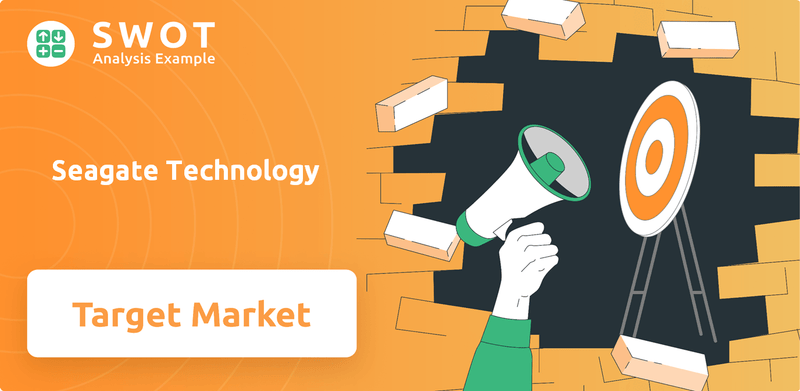
From personal computers to enterprise servers, Seagate Technology has adapted to meet the diverse needs of its customers. This exploration delves into Seagate's customer profile, geographical distribution, and purchasing behaviors, revealing how the company strategically targets its audience. Understanding the data storage market and market segmentation is key to appreciating Seagate's continued relevance and future growth potential.
Who Are Seagate Technology’s Main Customers?
Understanding the customer demographics and Seagate target market is crucial for analyzing the company's strategic positioning. Seagate Technology serves a diverse range of primary customer segments, spanning both Business-to-Consumer (B2C) and Business-to-Business (B2B) markets. The company's specialized product portfolio is strategically aligned to meet the specific needs of these varied segments.
Market segmentation allows Seagate to tailor its offerings effectively. The company's approach reflects a deep understanding of its Seagate customer profile, which includes both individual consumers and large enterprises. This segmentation strategy is essential for maintaining a competitive edge in the dynamic data storage market.
Seagate's ability to adapt to changing market demands is evident in its strategic shifts. For example, the increasing adoption of AI and cloud computing has significantly influenced Seagate's focus on mass-capacity storage solutions. This strategic realignment underscores the company's commitment to meeting the evolving needs of its diverse customer base.
In the B2C segment, Seagate targets individual consumers and gamers. Products include HDDs and SSDs for personal computers, gaming consoles, and consumer electronics. A recent example is the June 2025 launch of a 4TB storage expansion card for the Xbox Series X|S, highlighting the company's focus on the gaming consumer segment.
The B2B segment is a significant revenue driver for Seagate, primarily serving businesses requiring substantial data storage solutions. This includes cloud service providers, data centers, enterprise storage solutions, and OEMs. Seagate's strategic focus on mass-capacity storage solutions is directly aligned with the needs of this segment.
Seagate's B2B segment is crucial for its revenue and growth, with several key customer groups. These segments drive the demand for high-capacity storage solutions, reflecting the company's strategic focus on meeting the evolving needs of businesses. The company's approach to these segments is critical for its long-term success in the data storage market.
- Cloud Service Providers and Data Centers: This segment represents the largest share of revenue and fastest growth for Seagate. Cloud providers notably increased their purchase of high-capacity disk drives in Q4 2024, contributing to a nearly 50% rise in Seagate's revenues in its second fiscal 2025 quarter.
- Enterprise Storage Solutions: Seagate provides high-capacity storage solutions for various enterprises, including those in video surveillance, data analytics, and general business operations that require network-attached storage (NAS).
- Original Equipment Manufacturers (OEMs): Seagate sells products directly to OEMs, distributors, and retailers, maintaining a significant market share in the storage industry through its vertically integrated business model.
Seagate Technology SWOT Analysis
- Complete SWOT Breakdown
- Fully Customizable
- Editable in Excel & Word
- Professional Formatting
- Investor-Ready Format
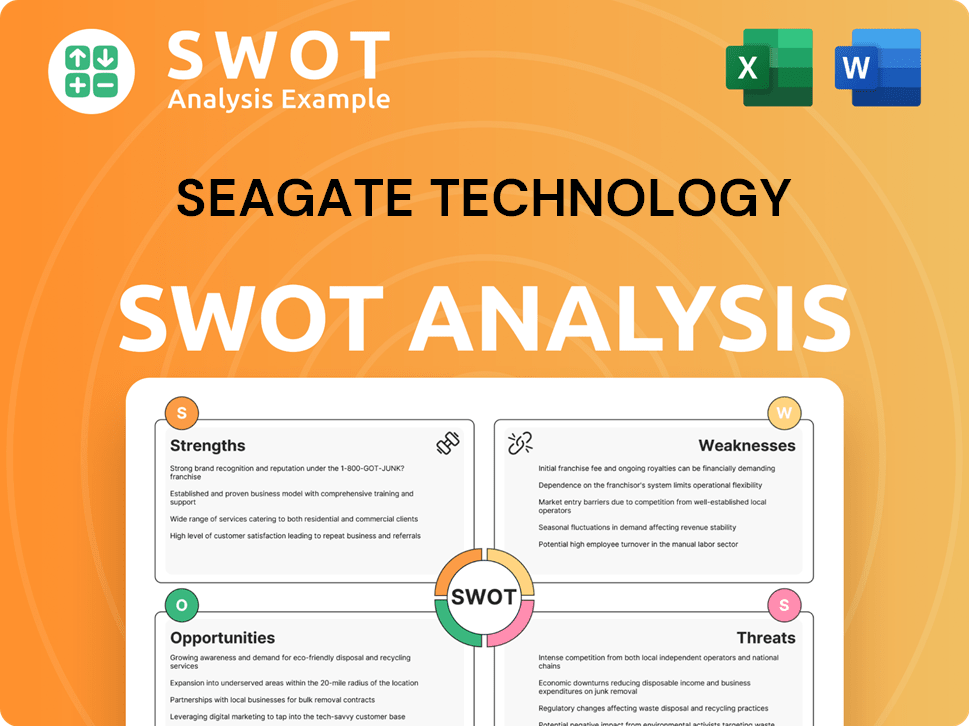
What Do Seagate Technology’s Customers Want?
Understanding the customer needs and preferences is crucial for [Company Name], shaping its product development, marketing strategies, and overall market positioning. The company’s customer base is diverse, encompassing individuals and organizations with varying data storage requirements. This customer-centric approach allows [Company Name] to tailor its offerings to meet specific demands, ensuring its continued success in the competitive data storage market.
The primary drivers for [Company Name]'s customers include capacity, reliability, cost-effectiveness, and increasingly, sustainability. The surge in data generation, particularly from AI and cloud computing, significantly influences these preferences. Businesses and individuals alike seek storage solutions that can handle the ever-growing volumes of data while remaining efficient and economical. This demand has led to a strong preference for high-capacity storage solutions, with a focus on innovations that increase storage density and reduce environmental impact.
Purchasing decisions are heavily influenced by the total cost of ownership (TCO) and the ability to scale efficiently. Customers often favor HDDs for workloads where cost control is paramount and immediate read access is less critical. This "nearline" storage approach balances performance and affordability. Furthermore, customers prioritize solutions that offer long-term data retention and explainability, especially for AI applications, where data availability is crucial for compliance and analysis.
Customers need storage solutions that offer high capacity and density to manage the increasing volumes of data. [Company Name] addresses this need with platforms like Mozaic 3+, enabling higher areal density drives. For instance, the company is already shipping 36 TB hard drives based on its Mozaic 3 platform.
Reliability is a critical factor for customers, ensuring data integrity and minimizing downtime. [Company Name] invests in technologies and rigorous testing to provide dependable storage solutions. The company's focus on reliability is essential for enterprise customers and in applications where data loss is unacceptable.
Customers are always looking for cost-effective storage solutions, balancing performance with affordability. HDDs remain popular for their cost efficiency, especially in "nearline" storage applications. [Company Name] offers a range of HDDs and SSDs to meet diverse budgetary needs.
Sustainability is becoming increasingly important, with customers seeking environmentally friendly solutions. [Company Name]'s Mozaic 3+ platform improves power consumption per terabyte by 40% and reduces embodied carbon by 55%. This focus on sustainability appeals to environmentally conscious customers.
Scalability is crucial for businesses that need to expand their storage capacity as their data grows. [Company Name] provides modular products and cloud-based services like Lyve Cloud to offer flexible and scalable solutions. These offerings cater to the dynamic needs of enterprise customers.
Data security and compliance are major concerns, especially in regulated industries. [Company Name] offers solutions that meet these needs, including specialized drives for the security industry. The company's focus on data protection ensures customer trust and compliance with industry standards.
- Security Industry: Specialized SkyHawk™ and Exos® drives are designed to meet the unique demands of surveillance and security applications.
- Enterprise Customers: Modular products, optimized off-the-shelf solutions, and cloud-based services like Lyve Cloud are provided to offer flexibility and scalability.
- Gaming Segment: The launch of the 4TB expansion card for Xbox Series X|S directly addresses the need for higher capacity storage due to large game file sizes.
- Cloud Providers: [Company Name] provides high-capacity, reliable storage solutions optimized for cloud environments.
- Data Centers: The company offers enterprise-grade storage solutions that meet the demanding requirements of data centers.
Seagate Technology PESTLE Analysis
- Covers All 6 PESTLE Categories
- No Research Needed – Save Hours of Work
- Built by Experts, Trusted by Consultants
- Instant Download, Ready to Use
- 100% Editable, Fully Customizable
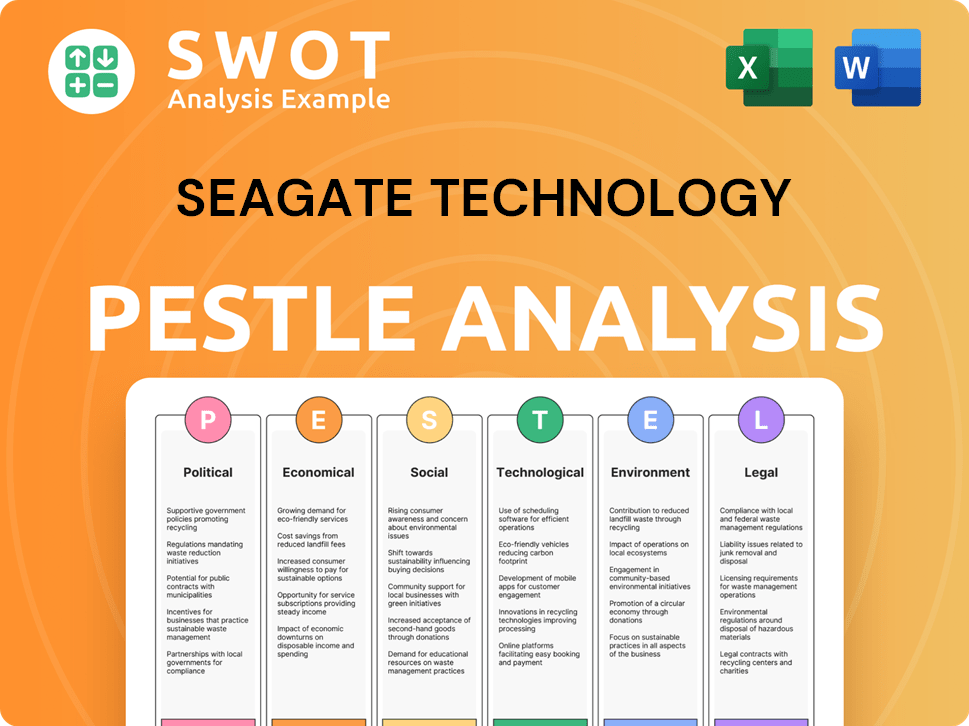
Where does Seagate Technology operate?
Seagate Technology maintains a substantial global presence, providing data storage solutions across numerous continents. The company's operations are strategically located in key regions, including Singapore, the United States, and the Netherlands, alongside a broad international reach. While specific market share data by country or region isn't always detailed in public reports, financial data reveals a wide geographical distribution.
The company's performance is supported by growing demand across almost all markets it serves, with the most significant expansion noted in the cloud sector worldwide. This suggests a strong presence in areas with advanced cloud infrastructure development and enterprise data center expansion. Seagate's focus on mass-capacity data storage for cloud and AI applications inherently links its geographical market presence to areas experiencing high data generation and consumption. Understanding the Competitors Landscape of Seagate Technology is crucial for contextualizing its market position.
Seagate adapts its offerings and marketing strategies to succeed in diverse markets. For instance, in the META (Middle East, Turkey, and Africa) region, Seagate emphasizes strengthening relationships with key accounts and promoting Video, Imaging, and Analytics (VIA) solutions while penetrating enterprise markets with high-capacity messaging. The dynamic economy of the UAE, with its rapid digital transformation and increasing demand for data storage, presents significant growth opportunities for Seagate's advanced integrated security solutions.
Seagate segments its customer base to better target its products and services. This segmentation allows the company to tailor its offerings to meet specific needs. Key segments include cloud service providers, enterprise customers, and consumer markets.
Seagate's geographic presence is global, with a strong focus on regions with high data consumption and cloud infrastructure development. The company has a significant presence in North America, Asia-Pacific, and Europe. Seagate's customer geographic location is a key factor in its strategic planning.
For enterprise storage, Seagate targets large corporations, data centers, and cloud service providers. These customers require high-capacity, reliable, and secure storage solutions. Seagate's target market for enterprise storage includes businesses across various industries.
Seagate's target market for SSDs includes consumers, businesses, and original equipment manufacturers (OEMs). These customers seek faster storage solutions for their devices. Seagate's customer needs and wants drive its SSD product development.
Seagate's approach to market entry and expansion often involves strategic partnerships and a focus on emerging markets. The company is actively exploring opportunities in new markets such as the Internet of Things (IoT) and artificial intelligence, where there is a growing need for data storage solutions.
- Strategic alliances with technology providers to enhance market reach.
- Collaborations to develop integrated solutions for specific industry needs.
- Focus on emerging markets to capitalize on growth opportunities.
- Partnerships to improve customer service and support.
Seagate Technology Business Model Canvas
- Complete 9-Block Business Model Canvas
- Effortlessly Communicate Your Business Strategy
- Investor-Ready BMC Format
- 100% Editable and Customizable
- Clear and Structured Layout
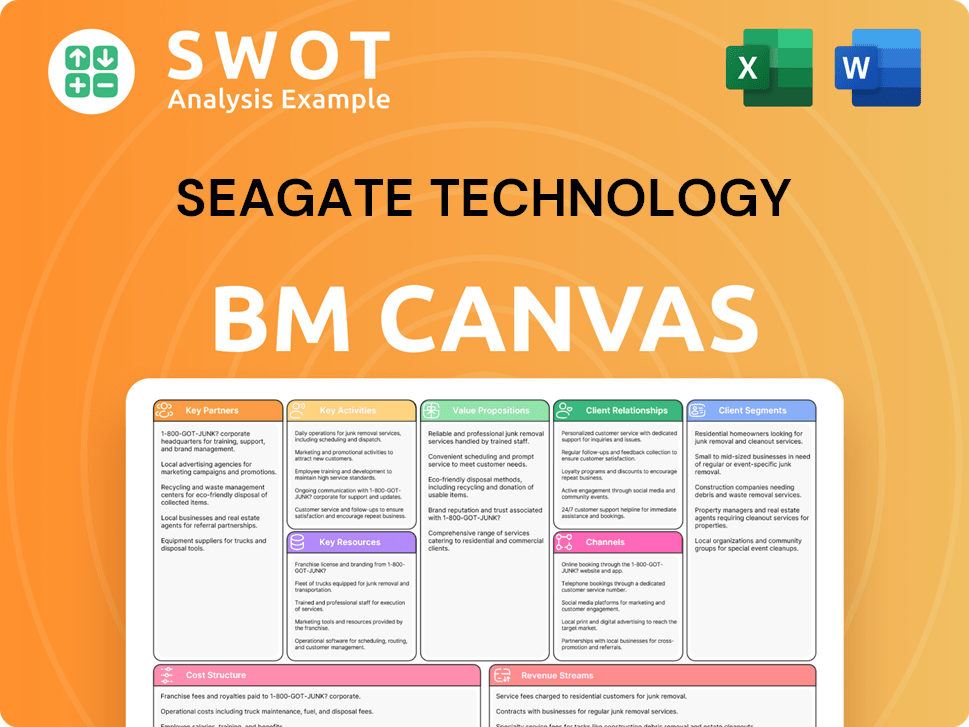
How Does Seagate Technology Win & Keep Customers?
Seagate Technology's approach to acquiring and retaining customers is multifaceted, focusing on the growing demand for data storage driven by AI and cloud computing. Their strategy for 2024-2025 is centered on providing cutting-edge, sustainable, and scalable storage solutions. This is crucial for meeting the dynamic needs of the AI-driven data landscape.
The company employs a variety of marketing channels, including digital platforms, social media, and traditional methods. A strong emphasis is placed on channel marketing, recognizing the importance of partners in driving mutual business growth. Seagate's innovation and product development are key to customer acquisition, with continuous enhancements to product offerings and investments in research and development. This ensures they remain at the forefront of the industry.
Customer retention is built on delivering reliable, high-performance, and cost-efficient solutions, fostering long-term value. Seagate's commitment to quality and technological advancement helps maintain customer loyalty. The company's 'build-to-order' strategy provides enhanced earnings visibility, allowing them to maintain a stable supply-demand balance and better serve major customers. Aligning with environmental concerns, Seagate also focuses on sustainability campaigns like promoting the Mozaic 3+ platform.
Seagate uses digital platforms, social media (X, Facebook, LinkedIn, YouTube), and traditional channels for marketing. They also focus on channel marketing, recognizing the importance of partners. This multi-channel approach helps reach a broad customer base.
Innovation is a key part of Seagate's customer acquisition strategy. They continually enhance product offerings and invest in research and development. The introduction of new products, such as the 36TB hard drives, addresses the growing demand for mass-capacity storage.
Seagate focuses on providing reliable, high-performance, and cost-efficient solutions to retain customers. Their commitment to quality and technological advancement helps maintain customer loyalty. The 'build-to-order' strategy provides enhanced earnings visibility.
Seagate is promoting sustainability through campaigns, such as the Mozaic 3+ platform, which offers improved power consumption and reduced embodied carbon. This aligns with customers' increasing environmental concerns. This platform is aimed to reduce power consumption by over 40%.
The Seagate target market includes cloud service providers, enterprise data centers, and consumers. Their focus on high-capacity storage solutions caters to the needs of these diverse groups. The company's financial performance, including consistent revenue growth and margin expansion, indicates successful customer acquisition and retention, particularly from cloud clients. Their ability to maintain a strong competitive and technology position in a strengthening demand environment further underscores effective customer strategies. For more insights into their strategic direction, you can explore the Growth Strategy of Seagate Technology.
Seagate's key customer segments include cloud service providers, enterprise data centers, and consumers. They tailor their products to meet the specific needs of each segment. The company's focus on high-capacity storage solutions caters to these diverse groups.
Channel partners are crucial for driving business growth. Seagate builds a strong and versatile partner ecosystem, providing training and tools. The SkyHawk Partner App is an example of how they support their partners.
Seagate invests in research and development to stay at the forefront of the industry. The Mozaic 3+ platform is an example of their commitment to innovation. This platform is designed to meet the increasing demand for mass storage.
Seagate is committed to sustainability, promoting products with reduced power consumption and embodied carbon. This aligns with the growing environmental concerns of their customers. The Mozaic 3+ platform reduces embodied carbon by 10%.
Seagate focuses on strong relationships with channel partners and direct engagement with cloud and enterprise clients. This suggests a robust B2B relationship management approach. This approach is critical for retaining major customers.
Seagate's financial performance, including consistent revenue growth and margin expansion, indicates successful customer acquisition and retention. This is particularly evident with cloud clients. The company's revenue for fiscal year 2024 was approximately $7.3 billion.
Seagate Technology Porter's Five Forces Analysis
- Covers All 5 Competitive Forces in Detail
- Structured for Consultants, Students, and Founders
- 100% Editable in Microsoft Word & Excel
- Instant Digital Download – Use Immediately
- Compatible with Mac & PC – Fully Unlocked
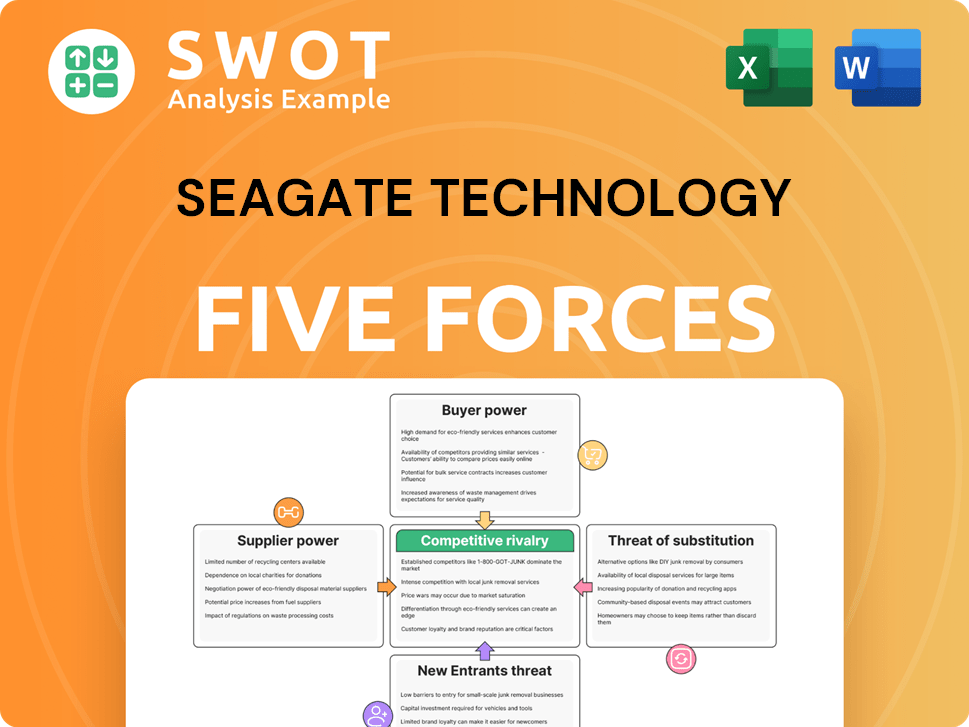
Related Blogs
- What are Mission Vision & Core Values of Seagate Technology Company?
- What is Competitive Landscape of Seagate Technology Company?
- What is Growth Strategy and Future Prospects of Seagate Technology Company?
- How Does Seagate Technology Company Work?
- What is Sales and Marketing Strategy of Seagate Technology Company?
- What is Brief History of Seagate Technology Company?
- Who Owns Seagate Technology Company?
Disclaimer
All information, articles, and product details provided on this website are for general informational and educational purposes only. We do not claim any ownership over, nor do we intend to infringe upon, any trademarks, copyrights, logos, brand names, or other intellectual property mentioned or depicted on this site. Such intellectual property remains the property of its respective owners, and any references here are made solely for identification or informational purposes, without implying any affiliation, endorsement, or partnership.
We make no representations or warranties, express or implied, regarding the accuracy, completeness, or suitability of any content or products presented. Nothing on this website should be construed as legal, tax, investment, financial, medical, or other professional advice. In addition, no part of this site—including articles or product references—constitutes a solicitation, recommendation, endorsement, advertisement, or offer to buy or sell any securities, franchises, or other financial instruments, particularly in jurisdictions where such activity would be unlawful.
All content is of a general nature and may not address the specific circumstances of any individual or entity. It is not a substitute for professional advice or services. Any actions you take based on the information provided here are strictly at your own risk. You accept full responsibility for any decisions or outcomes arising from your use of this website and agree to release us from any liability in connection with your use of, or reliance upon, the content or products found herein.